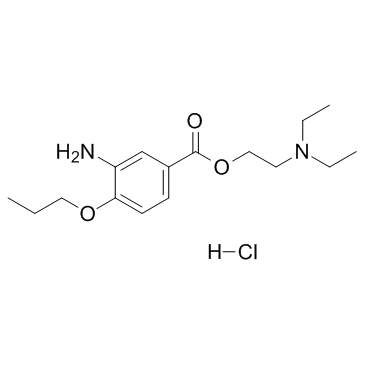Proparacaine Hydrochloride

Proparacaine Hydrochloride structure
|
Common Name | Proparacaine Hydrochloride | ||
|---|---|---|---|---|
| CAS Number | 5875-06-9 | Molecular Weight | 330.850 | |
| Density | N/A | Boiling Point | 434.4ºC at 760mmHg | |
| Molecular Formula | C16H27ClN2O3 | Melting Point | N/A | |
| MSDS | Chinese USA | Flash Point | 216.5ºC | |
| Symbol |

GHS07 |
Signal Word | Warning | |
Use of Proparacaine HydrochlorideProparacaine Hydrochloride is a voltage-gated sodium channels antagonist with ED50 of 3.4 mM.IC50 Value: 3.4 mM(ED50) [1]Target: Sodium Channelin vitro: Proparacaine is more potent and less toxic than cocaine [1]. Proparacaine significantly increases in FHV-1 (P < 0.01), C. felis, and 28S rDNA Ct values when fusidic acid is used [2].in vivo: Proparacaine inhibits corneal epithelial migration and adhesion through alteration of the actin cytoskeleton [3]. Proparacaine acts like bupivacaine or lidocaine and produces dose-related spinal blockades of motor function, proprioception and nociception. Intrathecal proxymetacaine also produces longer sensory blockade than motor blockade [4]. |
| Name | Proxymetacaine Hydrochloride |
|---|---|
| Synonym | More Synonyms |
| Description | Proparacaine Hydrochloride is a voltage-gated sodium channels antagonist with ED50 of 3.4 mM.IC50 Value: 3.4 mM(ED50) [1]Target: Sodium Channelin vitro: Proparacaine is more potent and less toxic than cocaine [1]. Proparacaine significantly increases in FHV-1 (P < 0.01), C. felis, and 28S rDNA Ct values when fusidic acid is used [2].in vivo: Proparacaine inhibits corneal epithelial migration and adhesion through alteration of the actin cytoskeleton [3]. Proparacaine acts like bupivacaine or lidocaine and produces dose-related spinal blockades of motor function, proprioception and nociception. Intrathecal proxymetacaine also produces longer sensory blockade than motor blockade [4]. |
|---|---|
| Related Catalog | |
| References |
| Boiling Point | 434.4ºC at 760mmHg |
|---|---|
| Molecular Formula | C16H27ClN2O3 |
| Molecular Weight | 330.850 |
| Flash Point | 216.5ºC |
| Exact Mass | 330.171021 |
| PSA | 64.79000 |
| LogP | 3.93940 |
| Storage condition | -20°C |
CHEMICAL IDENTIFICATION
HEALTH HAZARD DATAACUTE TOXICITY DATA
|
| Symbol |

GHS07 |
|---|---|
| Signal Word | Warning |
| Hazard Statements | H302-H312-H317-H319-H332 |
| Precautionary Statements | P280-P305 + P351 + P338 |
| Personal Protective Equipment | dust mask type N95 (US);Eyeshields;Faceshields;Gloves |
| Hazard Codes | Xn:Harmful |
| Risk Phrases | R20/21/22;R36;R43 |
| Safety Phrases | S26-S36 |
| RIDADR | NONH for all modes of transport |
| WGK Germany | 3 |
| RTECS | DG3065000 |
|
Enhanced Retinal Ganglion Cell Survival in Glaucoma by Hypoxic Postconditioning After Disease Onset.
Neurotherapeutics 12(2) , 502-14, (2015) The neuroprotective efficacy of adaptive epigenetics, wherein beneficial gene expression changes are induced by nonharmful "conditioning" stimuli, is now well established in several acute, preclinical... |
|
|
Differential bacterial gene expression during experimental pneumococcal endophthalmitis.
Ophthalmic Res. 53(3) , 149-61, (2015) Streptococcus pneumoniae (pneumococcus) is a potential cause of bacterial endophthalmitis in humans that can result in ocular morbidity. We sought to identify pneumococcal genes that are differentiall... |
|
|
Intraocular pharmacokinetics of intravitreal vascular endothelial growth factor-Trap in a rabbit model.
Eye (Lond.) 29(4) , 561-8, (2015) To determine intraocular pharmacokinetic properties of intravitreally injected vascular endothelial growth factor (VEGF)-Trap in a rabbit model.VEGF-Trap was intravitreally injected in 18 rabbit eyes.... |
| EINECS 227-541-7 |
| 3-amino-4-propoxybenzoate de 2-(diéthylamino)éthyle chlorhydrate |
| 2-(Diethylamino)ethyl-3-amino-4-propoxybenzolcarboxylathydrochlorid |
| Proxymetacaine Hydrochloride |
| Proxymetacaine Hcl |
| 2-(Diethylamino)ethyl 3-amino-4-propoxybenzoate hydrochloride (1:1) |
| Benzoic acid, 3-amino-4-propoxy-, 2-(diethylamino)ethyl ester, hydrochloride (1:1) |
| 2-(diethylamino)ethyl 3-amino-4-propoxybenzoate,hydrochloride |
| PROPARACAINE HCL |
| Proparacaine hydrochloride |
| MFCD00083467 |
| 2-(diethylamino)ethyl 3-amino-4-propoxybenzoate hydrochloride |
| ak-taine |